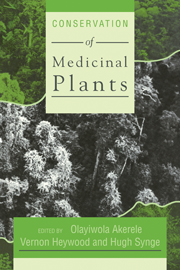Book contents
- Frontmatter
- Contents
- Contributors
- Preface
- Acknowledgements
- The Chiang Mai Declaration
- Introduction
- The Issue of Medicinal Plants
- Science, Industry and Medicinal Plants
- 6 Valuing the Biodiversity of Medicinal Plants
- 7 Economic Aspects of Exploitation of Medicinal Plants
- 8 Industry and the Conservation of Medicinal Plants
- 9 Information Systems and Databases for the Conservation of Medicinal Plants
- Techniques to Conserve Medicinal Plants
- Policies to Conserve Medicinal Plants
- Experiences from Programmes to Conserve Medicinal Plants
9 - Information Systems and Databases for the Conservation of Medicinal Plants
Published online by Cambridge University Press: 07 September 2010
- Frontmatter
- Contents
- Contributors
- Preface
- Acknowledgements
- The Chiang Mai Declaration
- Introduction
- The Issue of Medicinal Plants
- Science, Industry and Medicinal Plants
- 6 Valuing the Biodiversity of Medicinal Plants
- 7 Economic Aspects of Exploitation of Medicinal Plants
- 8 Industry and the Conservation of Medicinal Plants
- 9 Information Systems and Databases for the Conservation of Medicinal Plants
- Techniques to Conserve Medicinal Plants
- Policies to Conserve Medicinal Plants
- Experiences from Programmes to Conserve Medicinal Plants
Summary
Introduction
As the papers in this book show, there is a great deal of very diverse work on medicinal plants, and it is generating an ever-increasing amount of information. The work is remarkable in that it spans a wide range of disciplines and it is being done by a very widely scattered set of researchers, from the medical, chemical and botanical fraternities. It is a field in which there is little co-ordination of effort and in which its practitioners tend to work in isolation.
It is vital, therefore, to find a way of bringing the resulting information together and fitting it into a coherent whole, so it can be made widely available to those who need it. The pharmacognosists need to know the correct identity of the plants they study; the medical users need to know the correct formulations; the conservationists need to know which plants to conserve.
In today's world, this requirement can best be met by the development of a co-ordinated network of computer databases. Computers have been used in science for at least a generation and for handling bibliographies for almost as long. However, their use in databases on individual plants is much more recent. In botany, most of the earliest databases started in the 1970s, for example the (then) IUCN Threatened Plants Database (started in 1974-5), NAPRALERT (1975), and the Flora de Veracruz (1974-5). Even so, most botanical databases were created only very recently and are at an early stage of their evolution. We are now at a pioneering stage where the norms and standards for the next generation are rapidly being set.
- Type
- Chapter
- Information
- Conservation of Medicinal Plants , pp. 147 - 164Publisher: Cambridge University PressPrint publication year: 1991
- 1
- Cited by



